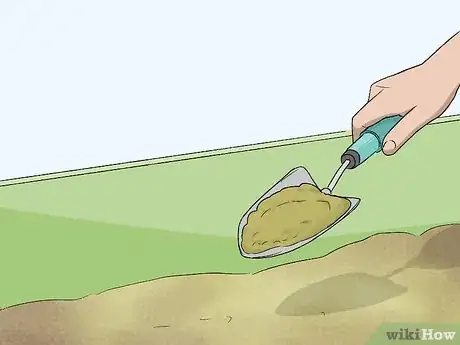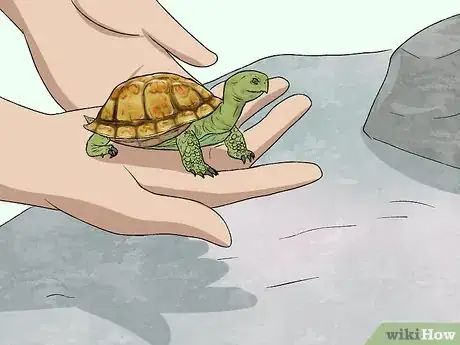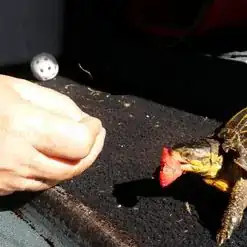This article was co-authored by Jaime Nalezny, DVM. Dr. Jaime Nalezny is an exotic animal veterinarian with over 15 years of experience, focusing on the care of birds, reptiles, amphibians, and exotic small mammals. Dr. Nalezny founded The Iguana Relocation Network and is on the board of directors for Midwest Avian Adoption & Rescue Services. She graduated from the University of Minnesota College of Veterinary Medicine in 2005.
There are 8 references cited in this article, which can be found at the bottom of the page.
wikiHow marks an article as reader-approved once it receives enough positive feedback. This article received 44 testimonials and 91% of readers who voted found it helpful, earning it our reader-approved status.
This article has been viewed 477,522 times.
Box turtles are small land-based turtles that can close up their shell completely. They're fascinating, independent little creatures and they should only be cared for by adults or very responsible kids. Their needs are complex, and – being reptiles – they're not going to like enforced cuddling and interaction, like puppies or kittens do. But if you want to take home this charming, scaly little creature, then you need to know how to care for it as well as you can.
Steps
Getting a Box Turtle
-
1Get your turtle from your local turtle rescue group or reptile society. Do an Internet search to find ones in your area, or check with the biology department at a nearby university. There are plenty of unwanted reptiles who need a good home. Buy captive-born box turtles from a reputable breeder or adopt rescued box turtles from a local herpetological society.[1]
- Pet stores almost exclusively sell turtles captured from their natural habitats, and you should look for breeders and dealers instead on reputable websites, or check out rescue organizations that have turtles that need good homes.[2]
-
2Find a good reptile vet. You can do this by asking around at reptile societies or searching on the Internet. Most vets don't know much about reptiles or other "exotics" because most of their training is concentrated on mammals. Avoid going to an average non-reptile vet when your turtle is in trouble. Dogs and cats from the "bread and butter" of a veterinary practice so a vet with a lot of knowledge about reptiles has accumulated it as a "labor of love" and is worth his or her weight in gold.
- This link will help you search for a vet: https://arav.site-ym.com/search/custom.asp?id=3661
- Visit your vet once a year when your turtle’s healthy or when you think it’s sick.
Advertisement -
3Decide whether you want to care for your turtle indoors or outdoors. If you have the right climate for box turtles, they do much better in a large, heavily planted outdoor enclosure. If you have to keep your turtle indoors, make sure you have a large enough space for their enclosure, at least 8 square feet (0.74 m2). Being outdoors will provide your turtle with fresh air, sunshine, and environmental enrichment that you just can’t replicate inside.[3]
- Don’t keep your indoor turtle in a glass aquarium, because many will obsessively peck at the glass walls.[4]
Making a Home for Your Turtle
-
1Build the walls of your outdoor enclosure. Make the turtle enclosure a minimum of 36 square feet (3.3 m2) for one or two turtles, and at least 50 square feet (4.6 m2) for three turtles. Use smooth-sided wooden planks about 12 inches (30.5 cm) in width. The walls should be completely vertical and at least twice as tall as the turtle, so that they can’t escape.[5]
- At the top of each corner, attach a triangular piece of wood that connects to each side. This will provide extra stability to your walls, and provide a "lip" over which a turtle can't climb.
-
2Predator proof the enclosure with wire mesh, netting, and hide boxes. Depending on where you live, you might have different predators such as dogs, racoons, foxes, skunks, coyotes, or even birds of prey. Protect your box turtle carefully. Make sure the fencing around your yard is secure and high so dogs and racoons can’t get in. Then, dig a trench at least 30 centimetres (12 in) deep around your enclosure. Bury poultry netting or wire mesh in the trench with rocks and attach it to the walls. This way, a digging animal won’t be able to gain access to your enclosure. Hang mesh over the top of the enclosure so predators can’t get in from above.[6]
-
3Build an indoor enclosure out of plywood or concrete. The walls should be adequately high so the turtle does not crawl out. If they are high enough -- at least two feet -- then you don't need a lid. If you do have a lid, make sure there is ventilation so the turtle can breathe. You can also use a Rubbermaid tub. If you are using a porous material, line it with pond liner so that it’s easier to clean.[9]
- Your indoor pen should be in a quiet room, away from slamming doors, heating/cooling vents and drafts.
- Put a humidifier in the room during winter or when your house is dry, because box turtles need high humidity to stay alive.[10]
-
4Make sure your turtle has enough warmth and light. If your turtle is outdoors and acclimated slowly to the temperature, it can get as cool as 45 °F (7 °C) at night. Turtles need UVB radiation which can’t get through your window glass, so place a full-spectrum fluorescent light no more than 18 inches (46 cm) above the substrate for an indoor enclosure. You should replace these lights every 9 months to 1 year to ensure that sufficient UVB radiation is reaching the animals. Turtles also need a basking light, so hang a 50 watt incandescent bulb with a reflector at one end of the cage.[11]
- Keep the lights on for 12 hours during the day, and turn them off at night. Turn the basking light off about 20 minutes before you turn off the other light.
- The background room temperature should be 72 to 75 °F (22 to 24 °C) during the day and a little cooler at night.[12]
-
5Add substrate to the bottom of outdoor and indoor enclosures. For outdoor turtles, you can use a mixture of clean, unfertilized soil and leaves, making sure that your turtle has a place to dig into and to hide in, and that there is enough soil for hibernation. You'll have to replace the soil around the wading pool as it becomes wet, preventing danger of frost. For indoor turtles, you can use potting soil or newspaper, but be sure to avoid wood shavings and corncob bedding.[13]
- Make sure the substrate is deep enough for the turtle to burrow under so they feel safe.[14]
- Different species of box turtle need different levels of humidity in their substrate, so do your research to figure out how often you need to mist their enclosure.
-
6Landscape the turtle enclosure. Fill his enclosure with edible plants like mint, common grass, or cooking herbs like thyme or chives. Make it an adventure playground with small logs to climb, flower pots to hide in, rocks to bask on, and of course a water bowl to soak in and drink from. Part of the enclosure must get direct sun (especially in the early morning for your turtle to bask in and warm up so he'll feel like eating) and part must have shade. Turtles appreciate a pile of cut grass that you dampen daily; they will like to burrow down and sleep there.
- You can do this whether you are caring for your turtle outdoors or indoors.
-
7Create a shallow pool that your turtles can always access. These turtles love wading in water, so make sure to have a little pool of water for your turtle to play in. Use room-temperature water, because they don’t do well in cold. It’s best to use a large, shallow cat litter pan or a shallow plant saucer, but a dish or pan will also work. Make sure the pan is sunk into the substrate so that the lip is level with the substrate and the turtle can approach from all sides.[15]
-
8Clean the enclosure regularly. Whether you are caring for your box turtle indoors or outdoors, it's important to keep its environment clean. You have to be diligent about cleaning its bedding at last once a week, cleaning its water bowl daily, and then cleaning the entire cage once a month, using dish washing soap (just make sure the soap is ammonia free).
- You can clean the enclosure with a very diluted 1:32 bleach solution, allow to air dry, then rinse. Don't use this on porous surfaces.
- Remove the turtle before cleaning and make sure that the soap mixture is completely gone before you put the turtle back so the chemicals in the soap or bleach don’t harm it.
Caring for Your Turtle
-
1Feed your turtle regularly. Adult turtles need to eat at least 3 or more times a week while young turtles must eat regularly. Turtles should be fed in the morning, and they need to eat a mixture of fruits, vegetables, and protein (50-75% of a young turtle's diet should be made up of protein; 20-30% for grown turtles). All fruits should be washed or chopped. You also need to make sure your turtle gets plenty of Vitamin A. Here are some foods that turtle love to eat:
- Protein: snails, slugs, grasshoppers, earthworms, crickets, baby mice, canned dog food, wax worms, cicadas, or sowbugs.
- Fruits: tomatoes, grapes, mangoes, melons, figs, pears, strawberries, plums, nectarines, raspberries, and apples.
- Vegetables: kale, cabbage, spinach, red leaf lettuce, bok choy, pak choi, sweet potatoes, carrots, mushrooms, dandelions, and squash.
-
Foods with Vitamin A: whole mice, yellow vegetables, dark leafy greens, food dusted with calcium carbonate, lactate, citrate, or gluconate (do this every 2-4 weeks if the turtle isn't getting enough foods with Vitamin A already).
- Know what to do if your turtle is stubborn and won't eat. Try feeding him or her bright, red, yellow, or orange foods, or live animals to stimulate his interest. Feed the turtles when they are the most active, which should be in the early morning or in the late afternoon. You can also try misting the cage a bit with water before feeding.
-
2Know if your turtle is sick. If your turtle is sick, then you need to be able to recognize his illness as soon as possible so you can take him to the vet. Here are some things to look out for:
- Changes in his eating or behavior for more than 2 weeks
- Gray or whitish areas on the turtle's shell or skin
- A softening of the shell
- A dry or flaky shell
- Dry, flaky, or transparent skin
- Skin with a red tinge
- Discharge from the nose or eyes
- Diarrhea or abnormal color to droppings or urates
- Swellings or lumps, especially over the ear
- Foam or discharge from sides of the mouth
- Elongated nose or beak
- Protruding tissue from cloaca/vent
-
3Be prepared for a hibernation period. Your box turtle will want to hibernate during the approximately four to six months of cold weather, depending upon where you live. Get your turtle a checkup from your experienced reptile vet beforehand. Your vet is the best one to clear up all your hibernation questions. Make sure your turtle is protected from harm and that his water stays warm during this period.[18]
-
4Be gentle with your turtle. Turtles don't like a lot of handling, but you can still build a relationship with your turtle without trying to cuddle it. Turtles can bite if they are unhappy, and those bites can really hurt! If you're quiet and careful around your turtle, he will trust and love you. Come to feed him at the same time, and soon enough, you'll build up a routine and your favorite scaly critter will be waiting for you. The more you get to know each other, the stronger your relationship will be.
- If you must pick him up, don't let his little legs flail away in empty space. Put one hand under his feet so he'll feel secure. Ideally, just have fun watching your box turtle hunt from afar. She will usually be most active in the morning and around sunset.
- If you have an indoor turtle, take it outdoors on nice days. But make sure you put it in an outdoor enclosure and keep an eye on it, because they can run fast! Stay with your turtle to protect it from potential predators, unless you’ve built a predator-proof outdoor enclosure.
- Wash and disinfect your turtle’s dishes away from where food is prepared, if possible.
- Wash your hands before and after handling your turtle, or your turtle's dishes.
Warnings
- Wash your hands with antibacterial soap after you handle turtles or change their water. Their droppings may carry salmonella and unless you have them tested by a lab you just won't know.[19]⧼thumbs_response⧽
References
- ↑ http://turtlepuddle.org/american/boxcare.html
- ↑ http://nebula.wsimg.com/91b04dd9708243802568b6103ac1de41?AccessKeyId=A3E784782F81D21389AD&disposition=0&alloworigin=1
- ↑ https://tortoise.org/general/boxcare.html
- ↑ http://turtlepuddle.org/american/boxcare.html
- ↑ https://www.corhs.org/index.php?get=content&pageid=126
- ↑ https://www.tortoisetrust.org/articles/securehabitat.html
- ↑ https://tortoise.org/general/boxcare.html
- ↑ https://www.corhs.org/index.php?get=content&pageid=126
- ↑ http://turtlepuddle.org/american/boxcare.html
- ↑ http://nebula.wsimg.com/91b04dd9708243802568b6103ac1de41?AccessKeyId=A3E784782F81D21389AD&disposition=0&alloworigin=1
- ↑ http://nebula.wsimg.com/91b04dd9708243802568b6103ac1de41?AccessKeyId=A3E784782F81D21389AD&disposition=0&alloworigin=1
- ↑ http://nebula.wsimg.com/91b04dd9708243802568b6103ac1de41?AccessKeyId=A3E784782F81D21389AD&disposition=0&alloworigin=1
- ↑ https://tortoise.org/general/boxcare.html
- ↑ http://www.turtlepuddle.org/american/boxcare.html
- ↑ http://nebula.wsimg.com/91b04dd9708243802568b6103ac1de41?AccessKeyId=A3E784782F81D21389AD&disposition=0&alloworigin=1
- ↑ http://nebula.wsimg.com/91b04dd9708243802568b6103ac1de41?AccessKeyId=A3E784782F81D21389AD&disposition=0&alloworigin=1
- ↑ https://tortoise.org/general/boxcare.html
- ↑ http://www.turtlepuddle.org/kidspage/hibernation.html
- ↑ https://lafeber.com/vet/basic-information-box-turtle/
About This Article
To care for your box turtle, build an outdoor enclosure out of wooden planks that's at least 4 feet by 6 feet, and bigger for more than one turtle. Alternatively, build an indoor enclosure out of plywood or concrete. For the substrate, combine topsoil with leaves so your turtle has something to dig into and mist the enclosure daily so it stays moist. Include plants such as mint or grass for your turtle to eat and make sure it has plenty of water. Finally, feed adult turtles 3 times a week with fruit and proteins, such as slugs or grasshoppers. For tips on how to make sure your turtle gets enough sunlight and how to know if it's sick, read on!

















































































